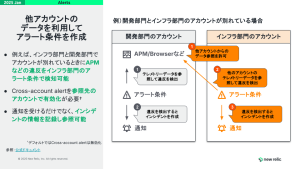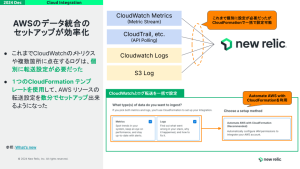Today, we added 20+ new capabilities to the New Relic Intelligent Observability Platform. In this post, we recap what’s new from our keynote at New Relic Now+ 2025.
Drive Business Uptime
To see all the innovations for Business Uptime, read the Business Uptime blog.
Agentic AI Integrations for ServiceNow and Gemini
The high volume of tools, manual processes, and disconnected systems jeopardize business performance in today’s enterprise. Constantly switching between tools wastes time, drains energy, and increases the likelihood of errors and poor decisions.
Only New Relic provides agentic integrations that extend business-critical observability insights into popular third-party platforms, such as ITSM/SDLC tools like GitHub Copilot, Amazon Q Business– and now introducing ServiceNow, and Gemini Code Assist. An open ecosystem of agent-to-agent orchestrations connected via natural language APIs enables users to automate research and complex tasks across ServiceNow and Gemini Code Assist workstreams, turning disparate data sets into business-critical insights.
- AI-powered productivity: New Relic agents connect to ServiceNow and Gemini Code Assist to automate and streamline processes.
- Intelligent, prioritized decisions: Intelligent orchestration prioritizes the right agent for the task, providing highly relevant and accurate response and recommendations.
- Eliminates context switching: Automates tasks and unifies essential insights for problem solving within a GenAI interface, delivering intelligence exactly where you work.
- User-defined context: Powerful New Relic retrieval-augmented generation (RAG) technology fueled by customer input (runbooks, Atlassian, documents, etc.) through Context Connector.
To learn more, visit the product webpage.
You can access this innovation in the New Relic platform here.
Predictions
Typically, observability alerts are triggered after a problem has occurred or a predefined threshold has been breached.This puts site reliability engineers (SREs) into a reactive mode to minimize the impact to their users—racing to prioritize signals and isolate root cause across vast amounts of performance data.
New Relic AI-powered Predictions leverages machine learning (ML) algorithms to analyze historical data, identify patterns, and forecast time-series metrics within a singular pane, as opposed to various views or processes found among competing products. Users can instantly add Predictions to a New Relic Query Language (NRQL) query to conduct ad hoc predictions on a given data set or as an alert condition that looks ahead for early warning signs of a problem.
- Intuitive and streamlined: ML algorithms analyze historical data, identify patterns, and forecast time-series metrics for instant insights within a singular, simplified view.
- One-click to predict: Instantly add forecasting to any NRQL query for ad hoc analysis and alert conditions.
- AI-powered causal analysis: Best-in-class compound and causal AI explains the “why” behind the prediction, enabling quick remediation.
To learn more, visit the product webpage.
You can access this innovation in the New Relic platform here.
Response Intelligence
Across an increasingly complex digital landscape, SREs and application engineers struggle to find the most accurate, real-time information to diagnose and repair issues before they affect users. They also lack insights needed to make fast, effective decisions and take mitigation actions.
Only New Relic offers Response Intelligence—an AI-powered solution that provides causal analysis, issue identification, and suggested remediation in a clear, unified view. The solution leverages our RAG platform, which includes the new Context Connector, enabling customers to integrate their own data sources and documentation, such as Atlassian runbooks and more. This feeds into a powerful mitigation engine that matches symptoms with solutions and provides AI-powered recommendations for next steps and a fast-path to remediation.
- Instant contextualized insights: All telemetry data combined with the New Relic platform and customer defined RAG info correlated and in context within a single view
- Immediate impact analysis: provides visual “Blast radius” of all affected systems.
- AI-powered recommendations: workflows to provide step-by-step mitigation for issues based on past incidents and unique logic from New Relic.
To learn more visit the product webpage.
You can access this innovation in the New Relic platform here.
Transaction 360
Imagine a single glitch bringing your entire checkout process to a halt. This scenario is common in modern applications built with interconnected services and components. During critical transactions, a small issue can trigger a flood of telemetry and alerts, overwhelming DevOps teams. This data overload, coupled with the need to navigate multiple dashboards, slows down troubleshooting, increases mean time to resolution (MTTR) and downtime.
Transaction 360 is the industry's first intelligent transaction monitoring solution. It goes beyond simple data collection by intelligently correlating telemetry, alerts, and change trackers across services for each transaction. This single, contextual view removes the need for DevOps teams to check multiple dashboards for transaction troubleshooting and reduces MTTR by 5x.
- Instant context: Automatically group and correlate only the relevant services and data for transaction issues.
- Root cause faster: Get a unified view of all services and components for each transaction in one place speeding up root cause analysis.
- Proactive issue detection: Spot and fix potential issues with dynamic flow maps that highlight anomalous services and dependencies within the critical path.
- Change impact analysis: Quickly pinpoint the impact of all deployments and configuration changes that impact transactions.
- Predict and optimize: Use historical data for transactions to understand trends, predict potential problems, and optimize performance.
To learn more, visit the product webpage.
You can access this innovation in the New Relic platform here.
Database Performance Monitoring
We’ve all been there: database issues slowing down application performance and no clear way to pinpoint the problem. As an SRE or engineer, it’s frustrating not having enough visibility into how your databases are performing. On the other side, DBA teams often rely on isolated tools, creating silos that make it hard to connect database performance to how the application is actually performing.
New Relic Database Performance Monitoring stands out by offering unified visibility into both your database and application performance. With detailed query-level insights and metrics. It equips you to quickly identify and resolve database issues—ensuring they never impact your applications. Our latest release adds three new on-host integrations (OHIs) for Microsoft SQL Server, MySQL, and PostgreSQL, allowing quick setup and easy collection of query-level telemetry and instant insights with a pre-built dashboard that combines query details, wait types, and explain plans—all in one place.
- Deeper visibility into databases: Easily identify slow database queries and anomalies with full visibility into query performance and detailed execution plans.
- Identify issues faster with pre-built dashboards: Get full visibility into your queries and database performance metrics, and explore issues with wait type histograms.
- Automatic correlation and relationship mapping: Connect your app and database performance while uncovering key dependencies with service maps.
To learn more, read the product documentation for MySQL, PostgreSQL, and Microsoft SQL.
You can access this innovation in the New Relic platform here.
Queues and Streams
Modern distributed systems heavily rely on message queues for asynchronous communication, enabling multiple producers to send messages to the same Kafka topic and numerous consumers to receive them. While this architecture is powerful, the absence of bi-directional visibility leaves DevOps teams struggling to pinpoint the root cause of performance issues. This lack of insight leads to extended downtimes and lost revenue.
New Relic Queues and Streams, which is fully integrated with our Intelligent Observability Platform, provides context-rich and end-to-end visibility for message queues and streams. Its distinctive bi-directional drill-down capability connects topics to both producer and consumer services, enabling DevOps teams to quickly identify and resolve issues such as slow producers, overloaded topics, or struggling consumers.
- Effortless setup: Quickly get started with our guided installation process, streamlining your message queue monitoring setup.
- Granular insights: Deep insights into Kafka health, down to the cluster, partition, broker, topic, producer, and consumer level.
- Root cause faster: Pinpoint root causes of performance issues quickly with bi-directional drill down capability from service to topic and back.
- Proactive issue detection: Identify potential issues with out-of-the-box alert conditions and real-time anomaly detection.
To learn more, read the product documentation.
You can access this innovation in the New Relic platform here.
Achieve Engineering Excellence
To see all the innovations for Engineering Excellence, read the Engineering Excellence blog.
Service Architecture Intelligence
Service Architecture Intelligence capabilities consolidate essential knowledge on digital landscapes into catalogs, scorecards, teams and maps for improved developer productivity
Service Architecture Intelligence - Scorecards
Engineering leaders in large distributed development organizations lack visibility into operational issues and a structured means to measure, evaluate, and improve the performance of teams. This can impact reliability, security, and compliance.
Service Architecture Intelligence Scorecards enable engineering leaders to create custom rules and reports that measure, monitor, and automate actions. Scorecards are created using New Relic Query Language (NRQL) rules and conditions that can align with your engineering best practices for almost any process, project, service, practice, or team.
Scorecards inform service owners, site reliability engineers (SREs), and other stakeholders throughout an organization of any gaps in observability, deviations from best practices, team performance, and status of critical processes such as production readiness reviews. It helps teams learn about and prioritize improvements to their services and performance. For example:
- Automate enforcement of best practices to scale team performance and software quality using rule evaluation summaries.
- Track efficiency and improve mean time to resolution (MTTR) in one place with limitless custom rules.
- Track and improve service reliability with no platform expertise required.
- Automate production readiness and DevSecOps compliance reviews using NRQL to create pass/fail scorecards.
To learn more, visit the product webpage.
You can access this innovation in the New Relic platform here.
Service Architecture Intelligence - Catalogs
For large dev organizations, complexity in tools, data, and environments can lead to engineers spending at least 20% of their time searching for information to complete troubleshooting, onboarding, or bug-fix tasks and projects. As a result, incident response times are extended and software release velocity is reduced.
Service Architecture Intelligence Catalog auto-discovers services, components, and contextual knowledge within a customer’s digital landscape to create a central system of record for the entire organization. Context can include documentation, ownership, performance, reliability, topology, and security data. The result? Engineers no longer waste time hunting for contextual information.
- Consolidate and centralize essential knowledge of services and components in one place to eliminate context switching.
- Eliminate knowledge silos and hours spent hunting for information.
- Scale developer productivity with immediate answers to resolutions.
- Increase release velocity by quickly finding artifacts needed to understand and work on any project.
To learn more, visit the product webpage.
You can access this innovation in the New Relic platform here.
Service Architecture Intelligence - Teams
When troubleshooting issues, engineers often need to contact the owners of specific services who have the expertise to help them. But this isn’t easy. Service ownership information is not documented, resulting in valuable engineering time spent searching instead of fixing.
Service Architecture Intelligence Teams lets you connect the entities you’re monitoring to the teams who own them. Now you can easily see who owns an entity and how to contact them. When you can easily see who owns an entity, and determine the ownership of interdependent services, users can speed up troubleshooting, enhance team collaboration, and improve operational efficiency.
- Accelerate team collaboration by clarifying resource ownership and helping different teams understand each other’s governance.
- Facilitate management of complex stacks that have shared ownership across multiple teams with a list of team members and the entities your team owns.
- Speed up troubleshooting by eliminating time hunting for service ownership information by centralizing team information in one place.
- Enrich insights and reinforce accountability with catalog and maps integrations that link to documentation, runbooks, and troubleshooting guides.
To learn more, visit the product webpage.
You can access this innovation in the New Relic platform here.
Service Architecture Intelligence - Maps
Engineering teams face challenges when onboarding new projects due to complex service architectures that are difficult to understand. A lack of full topology views that include interdependent services can lead to bug fixes that break unknown integrations and slow dev velocity.
Service Architecture Intelligence Maps deliver instant clarity by unifying your entire digital landscape in one intuitive view. Visualize complex service architectures in full topology views of main and non-main nodes with in-context details such as service ownership. Now users can quickly see and understand complex relationships when troubleshooting or onboarding a new project which speeds MTTR and software release velocity.
- Onboard new projects faster with complete understanding of architectural landscapes, ownership, interdependencies, and status.
- Accurately and confidently complete error-free bug fixes with complete views of interdependencies and their business impact.
- Improve incident MTTR.
- Navigate easily with custom groupings and views.
To learn more, visit the product webpage.
You can access this innovation in the New Relic platform here.
Cloud Cost Intelligence
Cloud costs are skyrocketing. The complexity and dynamic nature of the cloud makes it challenging to control sprawl, pinpoint cost drivers, detect anomalies—all of which are necessary for optimizing cloud spending. Business and FinOps leaders must bridge the gap between engineering decisions and business outcomes—enabling better cloud spend forecasting and data-driven decisions for future investments.
Cloud Cost Intelligence is fully integrated into the New Relic Intelligent Observability Platform, and automatically ingests our deep telemetry to deliver real-time, comprehensive visibility into AWS cloud and Kubernetes resource costs. With point solutions, you need both upfront instrumentation and continued maintenance to achieve full, real-time visibility. This means more resources, time, and money. Our fully-integrated solution uncovers detailed insights into cost trends, drivers, and impacts, empowering technical and business teams to make informed decisions about cloud spend, optimize costs at scale, and continue innovation for their customers.
- Complete visibility: See and manage cloud costs across your organization with detailed insights to optimize spending.
- Real-time cost estimation: Know the cost impact of compute resources before deployment to avoid billing surprises.
- Seamless integration: Automatically collects and visualizes real-time telemetry data for deeper cost insights without instrumentation needed.
- Leadership alignment: Makes cloud costs transparent, enabling teams to collaborate and optimize resources efficiently.
- Collaborative cost management: Empowers engineering, finance, product, and UX teams to align spending with business goals.
To learn more, visit the product webpage.
Interested customers can sign up to access the innovation here.
Security Rx
Security and engineering teams are challenged to identify, prioritize, and remediate volumes of vulnerabilities across multiple layers of the application stack. As a result, valuable engineering time is consumed in unnecessary triage and remediation.
Security RX for infrastructure consolidates, de-duplicates, and prioritizes remediation for vulnerabilities in infrastructure packages along with application and cloud risks. You can now reduce noise by helping teams focus on which libraries are loaded at runtime and have associated CVEs. This information is then correlated with other risk factors to provide a prioritized list of issues, making it easier to understand how vulnerabilities relate to application performance, user experience, and other key metrics you’re driving.
- Consolidate, contextualize and remediate infrastructure, cloud and application vulnerabilities, and misconfigurations in one console to reduce security backlogs and context switching.
- Continuously monitor Linux hosts using the same observability infra agents.
- Automate prioritization of security findings across all services, infrastructure, and cloud resources using threat intelligence and observability data.
- Cut the volume of vulnerabilities from point-in-time code scanning tools up to 97% with runtime verification.
To learn more, visit the product webpage.
You can access this innovation in the New Relic platform here.
NOTE: Security RX (Remediation Explorer) was previously known as Vulnerability Management within our platform.
Engagement Intelligence
If you can’t see what’s frustrating your users, you can’t fix it. Many businesses struggle to deliver smooth digital experiences due to a lack of end-to-end visibility into user engagement.
They typically have to manually collect and correlate user data, which is slow and inefficient, making it harder to diagnose and resolve friction points. The result? Poor experiences and customer churn.
Engagement Intelligence automatically collects and correlates user behavior for end-to-end visibility. It democratizes these user insights by making them accessible to every engineer that supports a digital experience, not just the frontend engineers. It goes one step further by pointing you to key replays with AI summaries, helping you quickly identify where backend issues impacted end users. This arms frontend and backend teams to collaboratively solve customer issues quickly, prevent major disruptions, and deliver smooth digital experiences.
- Full visibility, front to back: Automatically captures and connects user engagement logs across all sessions, helping backend teams see real user experiences.
- Deeper user insights, no effort: Out-of-the-box monitoring tracks clicks, rage clicks, typing, and scrolling—no manual setup needed.
- Automated data collection: The New Relic agent gathers and intelligently attributes user behavior across sessions.
- Faster issue resolution: Frontend and backend teams can quickly identify root causes with superior service mapping and contextual insights.
- AI-powered session summaries: Skip the noise—AI highlights the sessions that matter, saving time and speeding up troubleshooting.
Engagement Intelligence is available now. To learn more, visit the product webpage or read the product documentation.
Streaming Video & Ads Intelligence
Streaming video and ad providers face a constant challenge: delivering high-quality experiences across diverse devices and regions. When problems arise—like video playback buffering—developers and video/ad ops teams are forced to switch between specialized analytics tools for client-side issues and observability platforms for backend problems. This constant tool switching leads to lost context, delayed issue resolution, frustrated users, and increased churn.
New Relic’s Streaming Video and Ads Intelligence, is the industry’s first full stack streaming solution that unifies video quality of experience (QoE) metrics, app performance, backend infrastructure and ad analytics into a single platform. This comprehensive solution enables streaming media providers to quickly troubleshoot and deliver superior viewing experiences.
- Deliver exceptional QoE: Analyze factors impacting viewer experience, such as playback failures, video/ad attempts, and buffering.
- Maximize viewer engagement: Gain valuable insights into user engagement by tracking video/ad completion rates and concurrent view trends.
- Troubleshoot faster with full-stack visibility: Correlate data across your entire stack to quickly pinpoint the root cause of video/ad distribution issues.
- Resolve errors rapidly: Identify prevalent error messages linked to specific content or delivery methods to expedite troubleshooting.
- Optimize user experience: Visualize user sessions as timelines (video playback, ads, seeks, and metadata) to identify and resolve playback issues impacting viewer satisfaction.
Streaming Video and Ads Intelligence is available now. To learn more, visit the product webpage or read the product documentation.
Public Dashboards
Many organizations aim to share observability insights with teammates, executives, and even customers to drive smarter decisions and enhance visibility. However, sharing these insights with users who don’t have New Relic can be difficult. It often means you face extra licensing costs or security risks, leaving your stakeholders without the access to the insights they need.
New Relic makes sharing insights effortless with its Public Dashboard feature, allowing you to seamlessly share critical data with anyone—be it executives, team members, or customers outside the platform. New Relic’s unique unified database and query language allows you to create an interactive, customizable dashboard link in just a few clicks. Recipients can instantly access the observability data they need, and adjust time frames or settings to suit their specific requirements.
- Intelligent unified platform: Create and share dashboards easily with one database and query language.
- Instant sharable dashboards: Provide real-time insights and key metrics to audiences without requiring a New Relic login.
- Manage sharing activity: Audit user’s activity for link creation and revocation with NRAuditEvents and New Relic Query Language (NRQL).
- Built-in security controls: Role-based access control (RBAC) lets you control who can create, manage, or revoke links.
Public Dashboards is available now. To learn more visit the product webpage or read the product documentation.
Get The Right Telemetry
eAPM
To keep your Kubernetes workloads running smoothly and to avoid downtime, you need clear visibility into both your own apps and any third-party ones running on your Kubernetes clusters. However, achieving this requires continuous instrumentation and ongoing agent lifecycle management, which can slow down your team and reduce productivity.
eAPM simplifies performance monitoring for Kubernetes workloads with no-code instrumentation. With just one helm command, you can deploy an eBPF agent that automatically discovers and monitors all your apps—no coding required, no matter what language they’re in. You get instant visibility through the New Relic APM UI, helping you streamline your workflow, save time, and simplify agent management. New Relic sets itself apart by enabling effortless transitions between eAPM and full APM agents without disrupting your UI, dashboards, or alerts—no rebuilding necessary.
- No-code instrumentation: eBPF agents automatically detect and monitor all applications and services in a Kubernetes cluster—no code changes needed.
- Real-time debugging: Intelligent span sampling pinpoints critical issues, helping you quickly identify and fix performance problems.
- AI-powered insights: Monitor golden metrics, transactions, and database performance in the New Relic APM UI with automatic correlation across apps and Kubernetes clusters.
- Seamless transition to New Relic agents: Seamlessly switch to application performance monitoring (APM) agents for deeper insights without any UI gaps or the need to rebuild dashboards and alerts.
To learn more, visit the product webpage.
You can access this innovation in the New Relic platform here.
Agent Control and Fleet Control
Adding instrumentation and managing agents at enterprise scale is time consuming, error prone, and difficult to keep up to date. This leads to reduced productivity, observability blindspots, and increased security risks, as outdated monitoring agents may pose vulnerabilities.
Agent Control is a lightweight supervisory agent on your hosts and Kubernetes clusters that supports a wide variety of instrumentation options. Fleet Control remotely manages fleets of Agent Control. Together, they provide the most comprehensive observability control plane to centralize all instrumentation lifecycle tasks across your entire fleet of hosts and clusters.
Agent Control and Fleet Control allow teams to remove observability gaps, simplify fleet management at scale to increase productivity, and ensure up-to-date observability features.
- Centralize agent operations and reduce manual toil: Install, monitor, configure, and update all agents and integrations in one place.
- Upgrade fleets in a flash: Group agents by instrumentation needs and easily upgrade agent versions for entire fleets with a few clicks, no scripts needed.
- No telemetry blindspots: Manage agents on Kubernetes clusters with one lightweight supervisor that scales across your environment.
- Automate at scale: Streamline fleet operations with APIs for instrumentation-as-code.
To learn more, visit the product webpage.
Interested customers can sign up to access this innovation here.
Pipeline Control
Tech stacks are complex and generate vast amounts of data, often leading to rising data costs, inconsistent schemas, and disparate data sets. This adds noise and complexity, complicating the process of finding and resolving issues.
New Relic Pipeline Control provides a feature-rich rules engine to manage data, allowing users to filter unneeded data without requiring an external work stream. Unlike alternatives, Pipeline Control can manage all types of telemetry data, not just logs. And coming soon, Pipeline Control will allow teams to route, enrich, and transform all data in flight to maximize the value of data ingested.
- Manage all data types: Filter all your telemetry types—not just logs, but also events, metrics, and traces.
- Consolidate your pipeline tools: Manage telemetry data at scale, without adding a separate vendor to your workflow.
- Maximize data value: Reduce the noise-to-signal ratio by keeping only the data valuable to you.
- Place controls where you want: Set up rules in your own environment and/or the New Relic cloud.
To learn more, visit the product webpage.
Interested customers can sign up to access this innovation here.
次のステップ
Dive deeper into these innovations by reading our other blog posts:
- New Relic Now+ 2025: Guide to New Relic’s innovation announcements for business uptime
- New Relic Now+ 2025: Guide to New Relic’s innovation announcements for engineering excellence
- New Relic Now+ 2025: Guide to New Relic’s innovation announcements for DEM
本ブログに掲載されている見解は著者に所属するものであり、必ずしも New Relic 株式会社の公式見解であるわけではありません。また、本ブログには、外部サイトにアクセスするリンクが含まれる場合があります。それらリンク先の内容について、New Relic がいかなる保証も提供することはありません。



